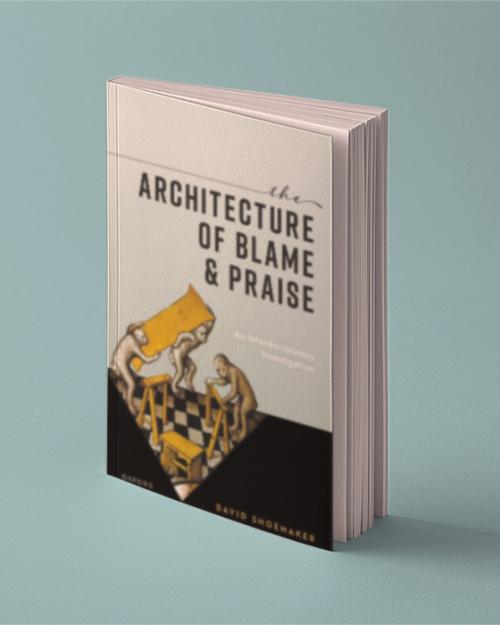According to philosopher David Shoemaker, blame and praise are the ways we hold people responsible for their actions or attitudes.
“They are responses, respectively, to people’s bad or good deeds, intentions, motives or attitudes toward us,” said Shoemaker, the Wyn and William Y. Hutchinson Professor in Ethics and Public Life in the Sage School of Philosophy, in the College of Arts and Sciences. “If you wrong me, I’ll respond with blame, and if you do something excellent for me, I’ll respond with praise.”
Shoemaker's work is in moral psychology, agency and responsibility, and he contributes to the College's emphasis on research and teaching in moral psychology. In a new book, “The Architecture of Blame and Praise,” he examines the complicated nature of both modes of response, teasing out their many varieties while defending a general symmetry between them. Drawing from psychology and experimental economics, the book considers mockery as a form of blame and builds a comprehensive system for the praise and blame people encounter every day.
The College of Arts and Sciences spoke with Shoemaker about the book.
Question: Why do you look at blame and praise as a system?
Answer: Until recently, philosophers have really only been interested in investigating blame, not praise, probably because only blame causes pain and so it’s the response that cries out for moral justification. In so doing, they have simply assumed that blame and praise are perfectly symmetrical responses, differing only in terms of the badness or goodness of the agent’s deed.
Nevertheless, some psychologists have been investigating blame and praise for a while now, and their findings strongly suggest that we don’t view blame and praise symmetrically, that there are significant disanalogies between the two.
Blame is part of a social practice that’s quite recognizable and stable – and so is praise. Indeed, they are both part of a single social system in which we respond to others and ourselves in various ways: We know blame and praise when we see it, even if not every instance looks the same as every other.
In the biological and social sciences, when we are trying to understand some mechanism, such as the heart, instead of asking, “What is it?” we have to ask the question, “What is it for?” – to pump blood, in the case of the heart. This is to ask a question about the thing’s function. And I think we need to make the same move regarding blame and praise.
The claim I defend in the book is that blame and praise are ways of policing, enforcing and buttressing norms. Once we understand that that’s the function of the system, we are on the road to providing an explanation of its blame and praise practices, in all their myriad forms and expressions.
Q: What is unique about mockery, and when does it come up as a form of blame?
A: I think mockery is the key to seeing the symmetrical architecture of blame and praise, as it is the proper negative analog to complimenting types of praise. To mock someone is to make fun of them for failing with respect to some norm – so it carries out the enforcement function of blame.
In my recent book on humor and morality, “Wisecracks,” I have a chapter on mockery that explores what it is and how rife it is in our interpersonal lives, with friends and family, for example: We tease and mock each other all the time. But being laughed at for a failure is valuable in getting us to do better next time.
The great British moral philosopher Frances Hutcheson articulated this point well, noting that “men have been laughed out of faults that a sermon could not reform.” So true. And complimenting people (“Great job!”) is mockery’s positive counterpart, as complimenting someone highlights their success relative to some norm in a pleasing, enjoyable way – what I call the “buzz” of praise, as opposed to blame’s “sting.”
We mostly mock and compliment people for nonmoral failures and successes. If you miss an easy basketball shot, or your souffle turned out terribly, you may be the target of a close friend’s mockery, for those athletic or culinary failures. But this fact suggests that we tend to respond to moral failures and successes with different kinds of blame and praise. We don’t mock people who murder, after all. Our blaming responses to moral failures are, instead, a kind of anger, and our praising responses to moral goodness are a kind of gratitude.
Q: How might this book benefit readers in their everyday lives?
A: This is a work primarily in academic philosophy, one which draws from the tools of social psychology and experimental economics, as well. It may not have much of a practical effect, except in unpredictable “trickle down” kinds of ways, with perhaps one exception: my discussion of mockery.
I don’t take mockery to be a bad thing in and of itself, despite what nearly every figure in the history of Western philosophy has said about it, usually under the description of “ridicule.” Plato, Descartes, Hobbes: They all hated it. But if we take it, as I’ve argued, to be a form of blame, its positive value is clear: It can be an incredibly effective way to get people to change their ways, to stick to the norms.
To succeed, though, it has to be on target – making fun of someone for an actual failure of theirs – and it needs to be funny. This can be hard to pull off, but it’s worth it. I think this is because, when it’s funny, mockery both stings and salves. Being laughed at is never particularly fun, but if the zinger is funny, the target ought to be able to laugh along with the laughers, and the enjoyment that amusement brings can soothe blame’s sting, while reminding the target not to screw up again next time.





